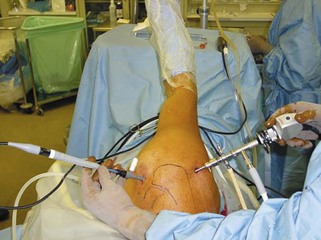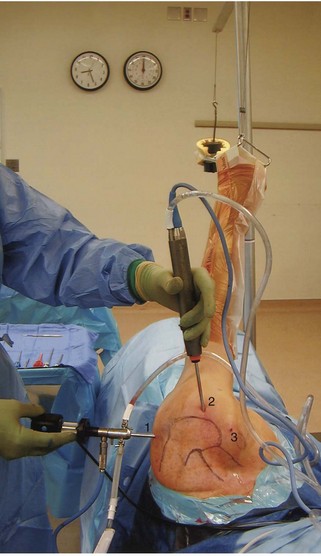Chapter 18 After completing this chapter, the student will be able to perform the following: 1 Explain the importance of appropriate use of surgery and medication to treat injury. 2 List indications and contraindications for massage. 3 Perform appropriate presurgical and postsurgical massage application. 4 Alter massage to interact appropriately with use of medication and injected substances. Arthroscopic surgery involves the use of fiberoptic cameras and small surgical instruments to visualize and treat intraarticular structures of the joint (Figure 18-1). The most common arthroscopic procedures include removal of loose bodies, trimming of articular cartilage flaps and meniscal tears, and débridement of scar tissue. Arthroscopic procedures can also be used to obtain a more accurate diagnosis through visual inspection of the joint. Although many of today’s magnetic resonance images are of very high quality, at times a visual inspection through arthroscopy is needed to make an accurate diagnosis. In particular, arthroscopy can be used to diagnose the size, depth, and condition of articular cartilage lesions. Sterile fluid is used to expand the joint, and a probe is frequently used to manipulate and investigate joint structures. Because the portal incisions are so small, stitches usually are not required to close the surgical wounds (Figure 18-2). FIGURE 18-2 Arthroscopy. (From Miller MD, Cole BJ: Textbook of arthroscopy, Philadelphia, 2004, Saunders.) As with any surgical procedure, risks are associated with arthroscopy, including the following: The goals of massage are to improve lymphatic drainage, to manage postsurgical edema, and to manage pain. For most surgical procedures involving arthroscopy, the patient will be home and ambulatory. Work on the surgical site should be avoided, but careful and gentle work around the joint may be appropriate. (See the discussion of wounds in Chapter 17.) This is considered acute care, and the surgical sites are wounds. Sanitation and infection control continue to be top priorities. If the patient has been instructed to do range-of-motion exercises, massage supports the movement pattern. Work with reflex patterns. Paired functional areas include the following: • Right shoulder, left hip, and vice versa • Right elbow, left knee, and vice versa • Right wrist, left ankle, and vice versa
Medical Treatment for Injury
Surgery
Arthroscopy

Massage Application
3 Days After Surgery
![]()
Stay updated, free articles. Join our Telegram channel

Full access? Get Clinical Tree


Medical Treatment for Injury
Only gold members can continue reading. Log In or Register to continue


